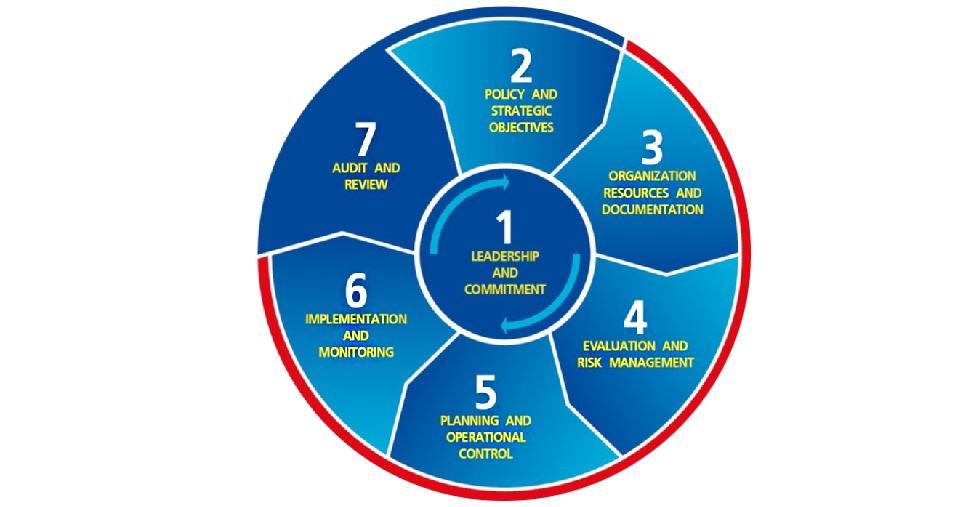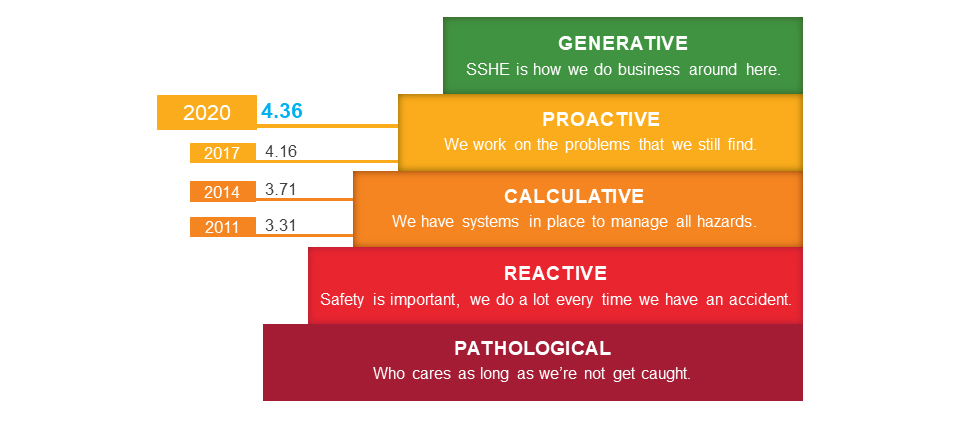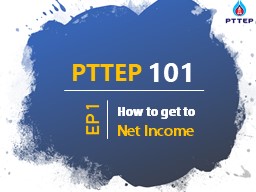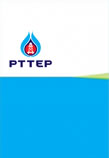Safety, Security, Health and Environment
Importance and Mission
At PTTEP, safety is one of our business principles under the aspiration to achieve zero incidents (Target Zero). A proactive safety culture has been instilled and emphasis is placed on personal safety of all workforce and process safety of our facilities. The Company implements the Safety, Security, Health and Environment (SSHE) Management System that is in line with our SSHE policy and complies with international standards and industries best practices, to ensure that everyone working with the Company returns home safely and that incidents are prevented to avoid causing impacts on stakeholders and the environment.
SSHE Vision and Mission
Vision
Zero Incident Organization
Mission
- Prevent all incidents through proactive personal and process safety management.
- Embed SSHE mindset and leadership at all levels toward a generative SSHE culture.
- Recognize SSHE as a foundation towards competitive performance and innovation for long term stakeholders value creation.
Goals
- Achieve zero incidents (Target Zero)
- Maintain personal safety of all employees and contractors and process safety of all facilities
Safety, Security, Health and Environment Policy (SSHE)
SSHE is fundamental for PTTEP's business. To achieve and sustain excellent performance toward relevant Sustainable Development Goals (SDGs), we put in place and adhere to an effective SSHE management system in order to ensure the safety and health of everyone involved in our operations and communities where we operate, environmental protection and the security of our people and assets.
To achieve our vision of being a zero incident organization, PTTEP shall:
- Strive for a generative SSHE culture through accountable leadership and involvement of all employees and contractors.
- Set measurable objectives, KPIs, targets, and action plans to deliver top-quartile SSHE performance, which is a line management accountability.
- Fulfil compliance obligations with applicable SSHE laws, regulations, internal requirements, and national and international standards.
- Manage SSHE risks to As Low As Reasonably Practicable (ALARP) throughout the PTTEP business lifecycle and when Management of Change (MOC) is applied.
- Promote an effective health management system and enforce zero drugs and alcohol programs in the workplace.
- Reduce environmental footprints in alignment with low carbon pathway, circularity concept, and positive Biodiversity and Ecosystem Services (BES) value creation.
- Protect all employees and the organization from pandemics, natural disasters, security threats, and vulnerabilities by effectively managing emergencies, crises, and business continuity.
- Empower everyone to exercise Stop Work Authority (SWA).
- Commit to continuous SSHE performance improvement via regular training, stakeholder participation programs, and upgrading systems and tools with technology.
The successful implementation of this policy requires total commitment from PTTEP employees and contractors at all levels by being mindful in every action.
(Remarks: PTTEP SSHE Policy is annually reviewed by the SSHE Council and approved by the Chief Executive Officer (CEO), the Director and Secretary to the Board of Directors)Safety, Security, Health and Environment Management System (SSHE MS)
PTTEP's SSHE Management System (SSHE MS) is an integration of the Company's safety, security, health, and environmental policies, vision, and corporate strategy, to mitigate risks induced by the Company's internal operations. The focus is on ensuring a safe work environment and prevention of work-related incidents, injuries and illnesses, as well as environmental impacts. The SSHE MS is also aligned with the International Association of Oil & Gas Producers (IOGP)'s guidelines as well as international standards like ISO 14001:2015 Environmental management System and ISO 45001:2018 Occupational Health and Safety Management System.
PTTEP's SSHE MS comprises of seven elements.

| SSHE Element | Addressing |
|---|---|
| 1. Leadership and Commitment | Top-down commitment and SSHE culture, essential to the success of the SSHE MS |
| 2. Policy and Strategic Objective | Corporate intentions, principles of action and aspirations with respect to SSHE |
| 3. Organization Resource and Documentation | Organization of people, resources and documentation for sound SSHE performance |
| 4. Evaluation and Risk Management | Identification and evaluation of SSHE risks, for activities, products and services, and development of risk reduction measures |
| 5. Planning and Operational Control | Planning the conduct of work activities, including planning for changes and emergency response |
| 6. Implementation and Monitoring | Performance and monitoring of activities, and how corrective action is to be taken when necessary |
| 7. Audit and Review | Periodic assessments of SSHE MS performance, effectiveness and fundamental suitability |
The Company has put in place the annual SSHE internal audit plan, to regularly monitor SSHE MS implementation. In 2022, 55 SSHE audits were carried out at the corporate level covering 100% of our exploration and production activities. External audits and certifications were also conducted in accordance with applicable international standards such as ISO 14001:2015 and ISO 45001:2018. Extent of such external audits cover our operations, including:
ISO 14001:2015 for Environmental Management System- Domestic Assets: Headquarters, Arthit, Bongkot (Greater Bongkot North – GBN and Greater Bongkot South - GBS), S1, PTTEP1, and Sinphuhorm
- International Asset: Zawtika Project in Myanmar, Project in Malaysia (Located in Sabah and Sarawak)
- Petroleum Development Support Bases: Songkhla and Ranong Bases
- Domestic Assets: Headquarters, Arthit, Bongkot (Greater Bongkot North – GBN and Greater Bongkot South - GBS), S1, PTTEP1, and Sinphuhorm
- Petroleum Development Support Bases: Songkhla and Ranong Bases
SSHE Culture Management
SSHE Culture development is essential for enhancing the SSHE performance of the organization. Since 2011, PTTEP has adopted the SSHE Culture improvement model based on the HSE Culture Ladder Model from the Energy Institute (EI), which identifies five (5) levels of HSE culture, ranging from Pathological to Proactive.

The SSHE culture survey is conducted every three (3) years. Regarding the first SSHE culture survey in 2011, PTTEP's SSHE Culture Maturity level was 3.31 (Calculative level). As a result, the SSHE culture improvement plan was developed and implemented. In 2017, continuous improvement was demonstrated from the survey results, in which the SSHE Culture Maturity Level for PTTEP reached 4.16 (Proactive level) from the highest at 5.
The SSHE culture maturity level of the entire organization increased to 4.36 (Proactive level) based on the 2020 SSHE culture survey results, with no distinction between the results of top management and employees. Regardless of position, all PTTEP employees have the same level of SSHE awareness. In addition, mode 1 contractors were initially engaged in the SSHE culture survey in 2020.
PTTEP establishes a 3-year plan (2021-2023 SSHE Culture Improvement Plan) to strengthen its SSHE culture. Periodically, continuous monitoring will be conducted to ensure the improvement of the SSHE culture maturity level in all operating areas and the achievement of the objective of becoming an incident-free organization (Target Zero). The following SSHE culture survey is planned for 2023.
PTTEP expanded the scope of the SSHE culture improvement and development technique in 2022 to include mode 2 contractors performing high-risk activities, as detailed in the contractor safety topic.
Embedding SSHE Culture
All PTTEP operations are instilled with a strong SSHE culture, which contributes to our improved safety performance as we strive to become a Target Zero organization. Even though incidents continue to occur, the Company remains fully committed to strengthening the SSHE culture, particularly emphasizing personnel safety and SSHE leadership. Moreover, the development of tools to support the PTTEP SSHE Leadership Program is underlined. This program was expanded to include frontline supervisors, i.e., PTTEP employees and contractors, through various trainings in the previous year.
As a robust SSHE culture begins with competent workforces, the Company identifies training needs on SSHE for employees and contractors in accordance with its SSHE Training and Competency Standard to provide them with the basic knowledge and skills required for their assignments. The following lists provide examples of notable training programs conducted in 2022.
- SSHE Leadership
- Risk Assessment and Job Safety Analysis
- Contractor Management
- Basic Incident Investigation and Root Cause Analysis
- Safe Lifting Operation
- Process Safety Management
- Corporate Emergency Management Team
Besides, the Company has continued to improve tools that promote SSHE culture, e.g., an electronic Safety Observation & Communication Card (SOC), Hazard Reporting Card (HRC), and Operational Control Verification Program. These tools primarily focus on workplace safety and increasing the observation and detection of unsafe behaviors and unsafe working conditions, with the aim of eliminating and/or reducing risks. PTTEP empowers all its employees and contractors to "Stop Work" when unsafe conditions or behavior is detected.
Emergency and Crisis Management
PTTEP recognizes that the petroleum exploration and production business requires high standards of safety. As such, PTTEP developed Emergency and Crisis Management Plans under the framework of the SSHE MS. The plans clearly outline a systematic structure to ensure the Company's readiness for emergency and crisis situations and their probable consequences to ensure the mitigation and recovery actions are put in place to reduce risk to the acceptable level, and giving priority to the protection of human lives, the environment, properties, and PTTEP's reputation. Joint exercises between the assets teams and corporate level personnel based on the Emergency and Crisis Management Plans are conducted on a regular basis. Results and feedback from these exercises are communicated to those responsible at the assets and corporate levels. They are used to improve the plans as well as to continuously enhance the competency of responsible personnel to effectively manage all forms of crisis situations.
Personal Safety
PTTEP believes incidents are preventable, to attain "Target Zero". This conviction is communicated repetitively from top management to all employees and contractors. Therefore, PTTEP emphasizes promoting safety culture in every stage of the work process. The Company's SSHE policy and management system were designed to meet relevant international standards, to manage work-related risks and ensure that everyone working with PTTEP returns home safely.
In 2022, the overall SSHE performance statistics in terms of the Lost Time Injury Frequency (LTIF) and the Loss of Primary Containment Rate (LOPCR) decreased compared to the previous year. Moreover, they were also better than the average performance of the industry peers reported to the International Association of Oil & Gas Producers (IOGP).
Following these incidents occurred in 2022, the Company strengthened our safety oversight of these assets by accelerating the closing of SSHE improvement gaps, communicating closely and enforcing strict measures to prevent the reoccurrence of such incidents. (Details on the number of personal incidents are shown in Health and Safety Performance Data.)
The investigation results of the incident showed that the main root causes were human factors, risk assessment, and inadequate supervision onsite, including inadequate communication of hazards and risks to workers. PTTEP focuses more on human factors, maintains high SSHE standards, and provides action plans by emphasizing the safety leadership of the frontline supervisors to manage and communicate hazards and risks at the site and promote the SSHE knowledge and competency of the workforce. These are to ensure that employees and contractors will be able to work safely.
Transportation Safety
PTTEP has established SSHE targets for motor vehicle and marine vessel incidents. Awareness of transportation incident prevention is promoted for all PTTEP transportation activities, including the Company's and contractors' vehicles and vessels, to guarantee that no incidents will occur and that all workers will work safely. In 2022, there was one motor vehicle accident occurred. This accident, therefore, led to the revision of the Company's safety control measures at both internal and external training centers, even if it was identified as low risk. However, no vessel accident was reported for four consecutive years. (Details of the transportation-related accidents are shown in Health and Safety Performance Data.)
Contractor Safety
PTTEP has continuously improved SSHE contractor management to ensure that all suppliers and contractors can work and return home safely. The Company has established a long history of the annual SSHE Forum that brings together suppliers and contractors to demonstrate PTTEP's strong commitment to improving SSHE and achieving Target Zero.
However, due to the COVID-19 pandemic in 2022, PTTEP arranged a virtual meeting to follow the control of the Ministry of Public Health instead. For subgroup meetings, they were organized with tailored content for each target group of contractors by the units directly dealing with contractors via virtual meetings. In addition, we continued to recognize and award contractors with good safety performance by maintaining our CEO's SSHE Performance Excellence Award and Recognition Program.
PTTEP also provides guidance on health risk assessment to our contractors, to ensure that their occupational health risk assessment is on par with PTTEP's. The results are communicated to relevant parties and support the formulation of a risk mitigation plan to lower risks to an acceptable level. Such will improve our employees and contractors' health. The health risk factors which were considered include physical, biological, chemical, ergonomic, and psychological hazards.
Furthermore, PTTEP provides contractors with guidance on health risk assessment to ensure that their occupational health risk assessment is comparable to ours. The results are communicated to the appropriate parties and support the formulation of a risk mitigation plan to lower risks to an acceptable level. This will improve the health of our employees and contractors. The health risk factors considered include physical, biological, chemical, ergonomic, and psychological hazards.
PTTEP’s mission involves the supply of oil and gas to meet the country’s energy demand. In the production process, oil and gas leaks can cause serious incidents that endanger lives, the environment and assets. Recognizing this potential, PTTEP integrates Process Safety Management into the SSHE Management System (SSHE MS) to prevent and mitigate Major Accident Events in our operations. The Process Safety Management system is based on the Energy Institute's guidelines which are in line with international manufacturing Process Safety Management requirements. It is based on the following four principles:
- Commitment to prevention of Major Accident Events and Process Safety;
- Understanding process hazards and risks;
- Management of process hazards and risks to As Low As Reasonably Practicable (ALARP) throughout the asset development lifecycle
- Learning and improving from experience.
These principles have been implemented by all relevant units across the organizations, to ensure the safety of all production and drilling equipment in all fronts, namely:
- Design Integrity – to rigorously review MAE risks and build facility commensurate with the risk using recognized industry standards and best practices;
- Maintenance Integrity – to maintain the built-in integrity throughout the asset's operating life;
- Operating Integrity – to operate with discipline, within the defined integrity envelope; and
- Well Integrity – to ensure Design, Maintenance and Operating integrity of our wells.
The integrity in the four fronts is identified as "barriers" to prevent and minimize hazards and their consequences. PTTEP regularly provides standard reporting and inspection and stresses that the responsibility for process safety lies in individuals according to the “My Barrier” program. Changes on these barriers are managed through suitable Management of Change (MOC) processes to ensure additional risks are properly managed. Furthermore, PTTEP reported and analyzed leakage-related incident statistics from the production process in order to identify the causes and plan preventive measures. In 2022, PTTEP focused on improving the following processes:
- Improve construction QA/QC including material quality assurance, qualification of contractors performing critical process e.g. welding.
- Ensure construction material compatibility with producing fluid and contaminants characteristic.
- Setup Technical Committee Meeting for each operating asset to monitor Process Safety performance and progress of asset specific LOPC (Loss of Primary Containment) reduction plan.
- Roll out nine Process Safety Rules (Respect hazards, Apply procedures, Sustain barriers, Stay within safety operating window, Maintain safe isolation, Walk the line, Recognize change, Stop if unexpected occurs, Watch for weak signals) which are adopted from IOGP’s Process Safety Fundamentals.
PTTEP has performed Security Risk and Threat Analysis and Assessment in our operation control, which identify risks and assist in a prevention system and appropriate risk mitigation. In addition, we monitor security-related situations for all our operating sites around the world in order to promptly apply corresponding security measures to manage such risk to our personnel, stakeholders and our assets.
The PTTEP medical and occupational health team has developed an E-Health Book system to be a company whose employees are physically and mentally healthy. It is an electronic health database that facilitates employee access to individual health records via the company's intranet. The E-Health Book contains employees' annual medical checkups and health risks, allowing the Company to plan health promotion activities and medical checkup programs that are appropriate for each employee and the Company as a whole. The team also conducted Health Risk Assessments (HRAs), and their results are used to enhance existing medical checkup programs pertinent to the employee's assigned work to prevent future health problems. PTTEP sets and tracks progress against targets for Total Recordable Occupational Illness Frequency (TROIF) which includes work-related ill health that results in Fatality (FAT), Lost Time Injury (LTI), Restricted Work Day Case (RWDC) or transfer to another job, and Medical Treatment Case (MTC). This applies to PTTEP operations, Head office, both onshore and offshore, and includes incidents involving employees and contractors.
The primary role of PTTEP's medical and occupational health team is to provide medical and occupational health advice to all employees and contractors. The team is also responsible for developing and maintaining occupational health standards, procedures, and approaches that promote a healthy and hygienic workplace, such as the Wellness Test, Ergonomic Consultation Campaign, and an annual medical and occupational health knowledge session for employees and contractors. (Course details and the number of participants are shown Health and Safety Performance Data.)
The Ministry of Public Health reclassified and announced that COVID-19 is currently an endemic disease (regularly occurring within an area or community). As a result, PTTEP has implemented a hybrid workplace program at the Head Office in Bangkok in order to continue normal business operations. Regarding both onshore and offshore operating assets, all activity plans have resumed normal operation. Nevertheless, PTTEP continues to place the utmost importance on occupational health and safety for workers and associated individuals. In accordance with public health measures, the following monitoring and preventative measures have been implemented to prevent the spread of the virus, such as COVID-19, Influenza, etc.
PTTEP commits to operating business with social and environmental responsibility by adhering to the Safety, Security, Health and Environmental (SSHE) Policy, which integrates the commitment to environmental protection, regulatory compliance, and continuous improvement. Company personnel, business partners as well as contractors working for or on behalf of the Company must implement this SSHE Policy. The summary of PTTEP's Environmental Management appeared in the Company's website; Environment Section. such as
- Climate Change Management
- Biodiversity and Ecosystem Services Management
- Spill Management
- Waste Management
- Water Resources Management



 ...the sea has become our home and so we are conscious of our responsibilities...
...the sea has become our home and so we are conscious of our responsibilities...




 PTTEP is E&P company in Thailand, exploring for sustainable sources of petroleum for the countries we operate
PTTEP is E&P company in Thailand, exploring for sustainable sources of petroleum for the countries we operate
 SIGN IN
SIGN IN SEARCH
SEARCH




 ISO 14001: 2015 and ISO 45001: 2018 Certificates for PTTEP Operations(as of 27 June 2023)
ISO 14001: 2015 and ISO 45001: 2018 Certificates for PTTEP Operations(as of 27 June 2023) Health and Safety Performance Data(as of 31 December 2022)
Health and Safety Performance Data(as of 31 December 2022)


